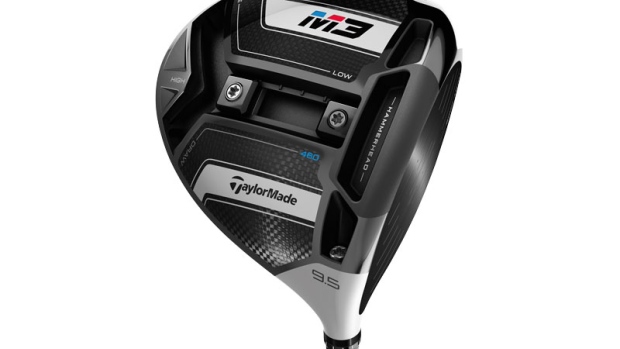Jan 2, 2018
TaylorMade giving a new twist to the driver
TaylorMade introduces their newest driver, the M3 which for the first time in nearly a century, re-thinks bulge and roll technology.
By Bob Weeks

If you’ve bought a driver over the last 50 years or so, it probably had a feature on the face known as bulge and roll. That means that the face of the club isn’t actually flat but has a curvature that goes vertically – top to bottom – and horizontally – heel to toe. It’s been in golf clubs for more than 100 years.
The thinking behind this is that the curves compensate for the spin of a ball on off-centre hits, using something called the ‘Gear Effect.’ So if you hit your shot off the toe of the club, it will have a left-to-right side spin (for right-handers). The bulge of the clubface makes the ball start farther to the right and, theoretically, means the ball will come back to the centre of the fairway.
But after extensive testing, and a lot of deep thinking and analysis of thousands of golfers’ shots, TaylorMade believes that the theory of bulge and roll isn’t perfect. In fact, it can be improved.
Hence its newest technology, the Twist Face.
According to the company’s testing, most players miss the centre of the clubface in two areas – low on the heel and high on the toe.
Sound familiar?
From once-a-week amateur players to PGA Tour pros, those are the two most common spots where shots are missed. The high-toe miss means a hook. The low-heel one? You guessed it – a slice.
TaylorMade’s Twist Face counters both of these. The new face has been twisted to a position where the toe is now open and has increased loft. Conversely, the heel is now closed and has less loft. The result is a face angle that will help correct those shots that are off centre, with the idea that the changes will bring the ball back to the centre of the fairway.
But wait a minute – wasn’t that what bulge and roll did? Well, yes, but TaylorMade said that the testing it did found that the old system worked well in theory with swing robots that delivered the club to impact perfectly. But in reality, while bulge and roll helped, the way most golfers swing, there was an over-correction where shots that were high-toe or low-heel were still hooking and slicing too much and ending up in the rough rather than the short grass. On average, a high-toe shot travelled eight-yards left of the target and on a low trajectory, and the low-heel one was six-yards right and high.
“The most interesting part of this story really is that bulge and roll which has been around for 130 years, really wasn’t questioned too much,” said Brian Bazzel, TaylorMade’s vice-president of product creation. “Over the last four years, we had the ability to look at golfer’s data, on the golf course, thousands and thousands of shots, hit all over the face, to discover how people were actually bringing the club into impact which was different than how we set up a robot. So we figured out that on your toe shot, you need a little bit more loft and you need to prevent that ball from going left based on how you’re presenting that club to the ball at impact.”
And, of course, the same holds true for the low-heel miss where you need a little less loft. The change resulted in an average of one yard off line on the high-toe shot and two yards off line on the low-heel. That’s a 14-yard difference across the face of the club, said TaylorMade.
“The face is completely changed in the contouring of it,” added Bazzel. “It will really help golfers bring their ball back on line, their intended line, when they mis-hit it all over the face.”
The Twist Face is featured in TaylorMade’s two newest driver offerings, the M3 and M4, the next generation after the highly successful M1 and M2.
Now before you get alarmed that you won’t be able to look down at a club that is all bent up like a Pringle potato chip, relax. When the club is set at address, there’s really very little of the bend that shows itself to the naked eye. If you turn the club upside down and look at it from the bottom, the twist is noticeable.

The two new drivers have additional technology. The M3 features a Y-shaped weight track where two 11-gram weights can be moved to position the centre of gravity in the club to a golfer’s preferred position. There is also a Hammerhead slot in the sole of the club, which was engineered to work in combination with the Twist Face and the company’s Speed Pocket to deliver maximum ball speed.
The M4 driver, which also has the Twist Face and the Hammerhead slot, doesn’t have as much adjustability as the M3, but has been built to maximize forgiveness.
It continues the company’s Geocoustic engineering which is a combination of sound and feel so important to consistency.
Both the M3 and M4 lines have full fairway woods and rescue clubs as well.
The drivers will be available at retail stores starting Feb 16. The M3 will go for $629 while the M4 is $539.
